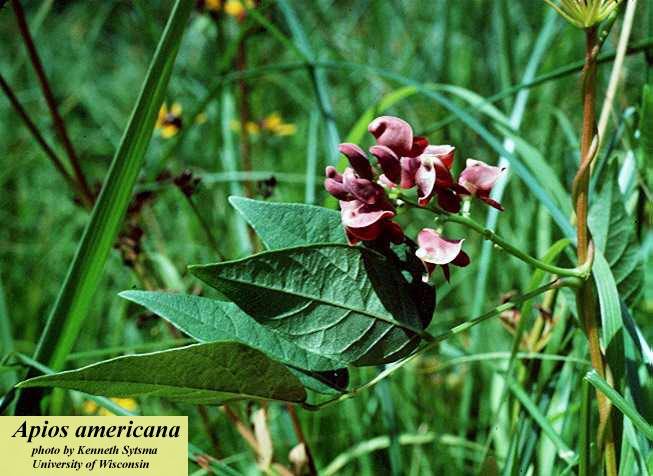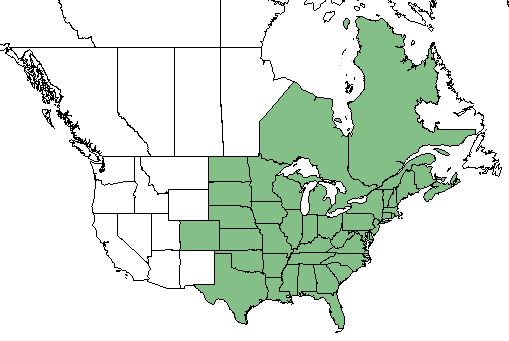Difference between revisions of "Apios americana"
m |
|||
| Line 45: | Line 45: | ||
The cord-like rootstalk contains edible tubers that have been eaten historically by Indians and the Pilgrims in soups, stews, or fried like potatoes. Cooked seeds can also be consumed by humans.<ref name="Ladybird"/> | The cord-like rootstalk contains edible tubers that have been eaten historically by Indians and the Pilgrims in soups, stews, or fried like potatoes. Cooked seeds can also be consumed by humans.<ref name="Ladybird"/> | ||
| − | + | ==Diseases and parasites== | |
In Baton Rouge, Louisiana, cucumber mosaic virus and ''Desmodium'' yellow mottle virus are reported to be causal agents of diseases in ''A. americana''.<ref name="Valverde et al 1990">Valverde RA, Provvidenti R, Clark CA (1990) Cucumber mosaic virus and ''Desmodium'' yellow mottle virus infections in wild groundnut (''Apios americana''). Plant Disease 74:151-153.</ref> | In Baton Rouge, Louisiana, cucumber mosaic virus and ''Desmodium'' yellow mottle virus are reported to be causal agents of diseases in ''A. americana''.<ref name="Valverde et al 1990">Valverde RA, Provvidenti R, Clark CA (1990) Cucumber mosaic virus and ''Desmodium'' yellow mottle virus infections in wild groundnut (''Apios americana''). Plant Disease 74:151-153.</ref> | ||
Revision as of 09:57, 19 February 2018
| Apios americana | |
|---|---|

| |
| Photo by the Atlas of Florida Plants Database | |
| Scientific classification | |
| Kingdom: | Plantae |
| Division: | Magnoliophyta - Flowering plants |
| Class: | Magnoliopsida - Dicots |
| Order: | Fabales |
| Family: | Fabaceae |
| Genus: | Apios |
| Species: | A. americana |
| Binomial name | |
| Apios americana Medikus | |

| |
| Natural range of Apios americana from USDA NRCS Plants Database. | |
Common Names: common groundnut;[1] groundnut;[2][3] wild potato; Indian potato;[3]
Contents
Taxonomic Notes
Varieties: A. americana var. americana; A. americana var. turrigera[1]
Synonym: Glycine apios[1][2]
Description
A. americana is a dioeceious perennial that grows as a forb/herb or a vine.[2] As a vine it climbs and produces maroon or reddish-brown pea-like flowers in compact racemes arising from leaf axils. Leaves are green and alternate.[3]
Distribution
This species occurs from Nova Scotia, New Brunswick, and Quebec, westward to Minnesota and South Dakota, southward to southern Florida and Texas.[1] The plant can also be found cultivated in Europe.[4]
Ecology
Habitat
A. americana occurs in marshes (tidal and non-tidal), wet thickets, streambanks, and bottomland forests.[1]
Phenology
In the southeastern and mid-Atlantic United States, flowering occurs from June through August and fruiting from July though September.[1] On the Florida panhandle, flowering has been reported in April and June through Septemeber, peaking in August and September.[5]
Pollination
The only legitimate pollinator known for A. americana are bees of the family Megachilidae.[4]
Use by animals
The cord-like rootstalk contains edible tubers that have been eaten historically by Indians and the Pilgrims in soups, stews, or fried like potatoes. Cooked seeds can also be consumed by humans.[3]
Diseases and parasites
In Baton Rouge, Louisiana, cucumber mosaic virus and Desmodium yellow mottle virus are reported to be causal agents of diseases in A. americana.[6]
Conservation and Management
Cultivation and restoration
Photo Gallery
References and notes
- ↑ 1.0 1.1 1.2 1.3 1.4 1.5 Weakley AS (2015) Flora of the Southern and Mid-Atlantic States. Chapel Hill, NC: University of North Carolina Herbarium.
- ↑ 2.0 2.1 2.2 USDA NRCS (2016) The PLANTS Database (http://plants.usda.gov, 16 February 2018). National Plant Data Team, Greensboro, NC 27401-4901 USA.
- ↑ 3.0 3.1 3.2 3.3 Plant database: Apios americana. (16 February 2018) Lady Bird Johnson Wildflower Center. URL: https://www.wildflower.org/plants/result.php?id_plant=APAM
- ↑ 4.0 4.1 Bruneau A, Anderson GJ (1994) To bee or not to bee?: The pollination biology of Apios americana (Leguminosae). Plant Systematics and Evolution 192:147-149.
- ↑ Nelson G (16 February 2018) PanFlora. Retrieved from gilnelson.com/PanFlora/
- ↑ Valverde RA, Provvidenti R, Clark CA (1990) Cucumber mosaic virus and Desmodium yellow mottle virus infections in wild groundnut (Apios americana). Plant Disease 74:151-153.